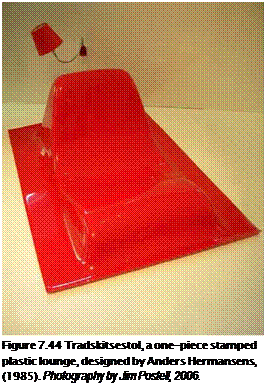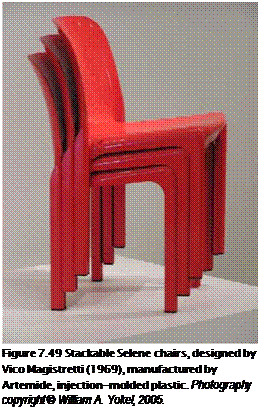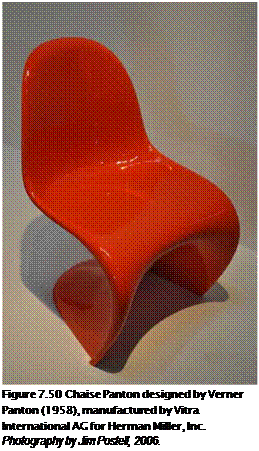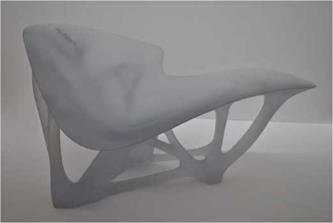Paper would seem to be an unusual material for furniture— it’s flimsy, fragile, and neither durable nor moisture resistant. Nonetheless, designers have used paper in innovative ways to make furniture out of paper and paper products. Innovative pieces include Frank O. Gehry’s Easy Edges series, a line of corrugated cardboard pieces designed and fabricated for Bloomingdale’s department store. Two particularly intriguing experiments in honeycombed paper becoming furniture are the Soft Seating Fanning Stools, produced by the Canadian-founded design company Molo (2006), and Tokujin Yoshioka’s Honey-Pop Armchair, designed in 2001, originally made of honeycombed paper (Figures 7.42 and 7.43). Yoshioka used layers of glassine, a traditional type of paper used in lanterns, bonded with glue. Driade has since produced an inspired version of the paper armchair in white polypropylene.
Molo’s soft expandable paper furniture is made from Kraft paper, using a honeycomb structure to provide expanding characteristics and structural support. Molo’s Fanning Stools paper furniture is available in a natural brown Kraft paper and in a deep black (dyed with bamboo charcoal ink).
Plastics
Plastics include a vast assortment of polymers used to manufacture an enormous number of furnishings. Plastics are unique in the number of ways they can be shaped, formed, textured, and colored. They are often associated with modern life. In the early 1900s, plastic was used for small objects, eyeglasses, and containers. The late 1950s witnessed the use of plastic in furniture with the work of Charles Eames, Eero Saarinen, and Verner Panton. In the 1980s, companies such as Kartell and Artemide used plastic as the primary material in almost all of their furniture production. Plastics have been made possible by their unique forming characteristics and offer excellent electrical, thermal, tensile, and insulation properties. Material scientists have developed many polymer materials for a wide number of applications. Particularly attractive to the furniture designer is the fact that plastic furniture can
 be made in one piece without joints or mechanical connections (Figure 7.44).
be made in one piece without joints or mechanical connections (Figure 7.44).
Plastics are made from polymers, which are chemical compounds composed of long molecules made up of chains of small, repeated units (monomers). Polymers are rarely used alone. Additives are often used to enhance the appearance, improve the strength, and change the characteristics of various plastics. Glass fibers can be used to strengthen plastic. Glass, carbon, paper, cotton, zinc, aluminum, magnesium, wood, talc, chalk, calcium, vegetable oil, and clay are some of the materials that can be incorporated into polymers to create different effects and properties. Polymeric products can be molded into any shape, are considered aesthetically pleasing, and have low density and a low coefficient of friction. Some plastics have excellent corrosion and impact resistance.
Plastics can be divided into two main categories. The first category has relatively short chains of molecules that are produced in the polymerization process. These polymers are called thermosetting plastics. In the second category of polymers, polymerization results in relatively long molecular structures called thermoplastics.
Thermosetting Plastics
A chemical change occurs in thermosetting plastics during the curing process. This irreversible condition is usually induced by mixing a resin with an activator, which coincides with the molding or forming of the component into its final shape. Thermosets cannot be re-formed after they have cured. Any subsequent shaping is carried out using traditional wood – or metalworking tools.
Phenol-formaldehyde (PF) resins are used widely for laminate materials for tables and countertops (Figure 7.45). PF resins are also used in wood glues, reinforced laminates, and moldings such as car distributor caps and electrical plugs. Common trade names are Bakelite and Melamine.
Urethane resins are available in a variety of densities, hardness, and working life. Molds for casting can be made of silicon rubber, aluminum, polyurethane, or epoxy. Resin urethanes are designed for easy mixing by hand without the need of heating prior to pouring into the mold. The Pratt chair (no. 3), designed in 1984 by Italian furniture designer Gaetano Pesce, is made from urethane resin (Figure 7.46).
Polyurethane resin can be resistant to UV light. The Lounge chair (2006) is made of polyurethane resin, whose ability to be formed led to the creation of peices inspired by organic forms found in nature, such as natural plants and human bones (Figure 7.47). It is one of two pieces of a series called "Bone Furniture" designed by Joris Laarman in collaboration with the Dutch design foundation Droog, sponsored by the Barry Friedman Gallery of New York.
Urea-formaldehyde (UF) is used in wood glues, buttons, colored toilet seats, and domestic electrical fittings.
Epoxides are specific epoxy glues for metal, glass, and other materials. They are used for encapsulation of electrical components, glass reinforcement, powder coatings, adhesives, marine protection coatings, molds, and dies for thermoplastics (Figure 7.48).
Polyester is used in finishes, fiberglass-reinforced boat hulls, car bodies, vehicle cabs, weather enclosures, and many applications where, in the face of weather conditions, aesthetics and durability are important. Polyester is also used in lacquers for wood finishing.
|
|
|
|
|
|
|
|
Thermoplastics
Thermoplastics soften when heated and regain their rigidity when cooled. Various thermoforming processes have been developed for changing the shape of thermoplastic sheets by exploiting this property, including:
■ Line bending
■ Vacuum forming
■ Dip coating
■ Dome blowing
■ Blow molding
■ Rotational molding
■ Injection molding
■ Extrusion (push and pull methods)
Unlike thermosetting plastics, no chemical change occurs when this type of plastic is heated and cooled. When a thermoformed object is reheated, it will soften again and can be re-formed or left to return to its original shape.
Between the 1920s and the 1940s, new synthetic fibers and resins such as nylon, acrylic, and polyester were introduced. These materials were used to make clothing, industrial equipment, and Plexiglas. Nylon is strong and lightweight. Bases of office chairs are manufactured using nylon. These components are usually injection molded and filled with fillers such as glass or minerals to achieve higher durability. Because nylon absorbs humidity from the air, it is not recommended for humid areas.
Following the development of these materials, new compounds derived from the byproducts of the oil-refining process entered the market. Four materials synthesized from such hydrocarbon by-products are:
■ Polystyrene (PS) is a brittle thermoplastic known also as Styrofoam™. Polystyrene foam is used in packaging. It is processed by expanded foam molding.
■ Polyvinyl chloride (PVC) is used in plumbing fixtures and weather-resistant home siding.
■ Polyethylene (PE) is the most common thermoplastic in everyday use. It is easy to work and can be used in line bending, vacuum forming, dip coating, injection molding, and blow and rotational molding. It is flexible, inexpensive, and widely used in packaging and ski bottoms. It is also resistant to humidity and water. Polyethylene foam is lightweight and can be dyed in a wide choice of colors.
■ Polyurethane (PU) is the most widely used of the elastomer foams. It is a self – skinning material, and therefore produces a usable, durable finish when fully cured.
Acrylonitrile butadiene styrene (ABS) is a synthetic polymer thermoplastic available since 1948. Mostly vacuum-formed and injection molded, it was used for making chairs in the mid-1960s. A fiberglass-reinforced plastic was used to produce Vico Magistretti’s Selene (Figure 7.49), manufactured by Artemide in 1969, as well as Anna Castelli Ferrieri’s Stooble (combining the words table and stool), produced by Kartell in 1987. ABS is used to make injection-molded chairs, storage systems, tables, and accessories. The material is generally opaque, though it can be transparent. ABS has an excellent resistance to impact and is easily dyed, allowing metallic tints to be obtained. ABS can be stabilized and made resistant to UV radiation and therefore can be suitable for external applications.

 Nylon is commonly used as a fiber in textiles, but it is also available in rod, tube, sheet, and powder. Nylon has high resistance to abrasion, low friction characteristics, and good chemical resistance. Nylon will absorb water and will expand in wet or humid environments. It resists burning, but when combusted, it will bubble. It can be used for injection forming and dip coating and can be precisely machined using power tools.
Nylon is commonly used as a fiber in textiles, but it is also available in rod, tube, sheet, and powder. Nylon has high resistance to abrasion, low friction characteristics, and good chemical resistance. Nylon will absorb water and will expand in wet or humid environments. It resists burning, but when combusted, it will bubble. It can be used for injection forming and dip coating and can be precisely machined using power tools.
Polyvinyl chloride (PVC) is a rigid or plasticized thermoplastic material first commercially developed in 1928-1930. It is one of the cheapest, most versatile, and most widely used polymers. PVC is banned from use in some countries, as it releases dioxin and produces carbon dioxide when it is burned—usually after the end of its useful life. It is also a known carcinogen. In its pure form as a thermoplastic, it is rigid. Joe Colombo’s Tube chair (1969) is made of rigid PVC, plastic, foam, and fabric. The Tube chair was manufactured by Flexform. When incorporated with plasticizers, PVC can be made flexible as is the webbing for Giandomenico Bellotti’s Spaghetti chair, produced by Alias.
Polyethylene (PE) is a lightweight thermoplastic material developed in 1933. As a high-density, rigid plastic, it is used in injection or blow molding for a range of plastic furniture. It has a waxy feel and is available in a wide range of colors. PE is characterized by easy processing and chemical resistance, and strikes a balance between strength and rigidity. PE is a low-cost, recyclable material. The stacking PE child’s chair designed by Richard Sapper and Marco Zanuso (1983), produced by Kartell, is an example of PE used for seating.
In 1963, Karl Ziegler received the Nobel Prize in Chemistry for his work in developing a method for creating a high-density PE molecule with a very high melting point that could be manufactured at low temperatures and low pressures. PE has been made into dishes, squeezable bottles, and soft plastic materials.
Polypropylene (PP) was discovered in 1954 but was not used in furniture design until 1963, when the first self-supporting, injection – molded Hille stacking chair was produced. Many of the polymer components (seat pan) of the 4822-44 stools, designed by Anna Castelli Ferrieri in 1979 for Kartell, were made of PP, which is recyclable. PP resists water well and can be used at high temperatures due to its high fusion point.
Polystyrene (PS) is a rigid plastic used in molded products. It is the most familiar and cheapest of all polymer foams. The flammability of PS foam was, at one time, a cause for concern. New flame retardants allow PS foams to meet current fire safety standards. There are environmental concerns about using PS because it is not biodegradable. The Chaise Panton, designed by Verner Panton (1958) was manufactured by Vitra International AG for Herman Miller using PS, using the injection mold process (Figure 7.50).
Polyurethane (PU) is one of the most important synthetic plastics used in furniture. It can be made flexible, rigid, or structural, and is
used for coating textiles and as a wood finish. It is used as an upholstery foam when flexible and as a chair frame shell when rigid. Non-Rubber, designed by Boris Berlin and Poul Christiansen of Komplot Design, utilizes PU mixed with an elastomer as the primary material, which is then injected into a two-part aluminum form around a continuously welded steel frame. The result is a reductive, iconic, and functional stackable chair. In 1970, the architect Mario Bellini used a self-skinning colored PU in Teneride (Figure 7.51), manufactured by the Italian furniture company, Cassina.
Polycarbonate (PC) offers one of highest impact resistance ratings among the polymers. It is many times stronger than glass. PC is available in several grades, including UV stable, high flow, flame resistant, water resistant, high optical clarity, and wear resistant.
Lexan PC is a registered trademark for SABIC Innovative Plastics™ and one of the most widely known plastics. Available in sheets with a unique combination of high-impact strength and thermoformability, Lexan is ideally suited for security applications. No other plastic can match Lexan’s combination of light transmittance (clarity) and the ability to withstand extreme impact. It is easy to machine and weathers well.
Less impact resistant than Lexan is acrylic. Kartell produces the LCP Chaise (Low Chair Plastic) designed by Maarten Van Severen, which is made from an engineered acrylic called methacrylate. The LCP Chaise is formed by a sculptural loop of clear or colored methacrylate, joined with rubber buffers to allow gentle movement from the user (Figure 7.52).
Carbon and Poly Fiber Carbon
In 1964, British engineer Leslie Phillips made carbon fibers by stretching synthetic fibers and then heating them. The resulting fibers were twice as strong as the same weight of steel. Ron Arad’s Well-Tempered chair (1985) was originally fabricated out of four sheets of stainless steel that were bolted together. In 2002, it was reintroduced at the Milan Furniture Fair entitled Bad-Tempered chair, made of a specially developed plastic using glass, carbon, and Kevlar fiber laminated in resin. Both designs are produced by Vitra Edition (Figure 7.53).
The first chair to use molded carbon fiber in an epoxy-resin matrix and polyurethane foam was the Light Light chair, designed by Alberto Meda in 1987 for the Italian company Alias. It is remarkably light and durable. In response to the desire for improved comfort and increased sales, Alberto Meda designed Soft Light in 1989, a composite of an aluminum honeycomb core with a skin of carbon fiber and an elastomeric seat pan and seat back held in tension by the chair’s side and back support.
MYTO chairs were designed by German-born designer Konstantin Grcic (2007). These chairs are made of BASF Ultradur® (a high-speed plastic) and are produced using a single – injected piece of an advanced plastic that has been used in the automotive industry. The molecular characteristics and strength of BASF Ultradur allow for a sleek transition from thick to thin cross-sections. This characteristic enables the cantilever in the seat pan, which is unexpected in a plastic chair (Figure 7.54).







